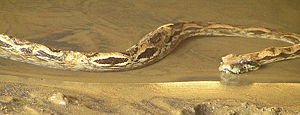Northern Madagascar boa
| Northern Madagascar boa | ||||||||||||
|---|---|---|---|---|---|---|---|---|---|---|---|---|

Northern Madagascar boa ( Acrantophis madagascariensis ) |
||||||||||||
| Systematics | ||||||||||||
|
||||||||||||
| Scientific name | ||||||||||||
| Acrantophis madagascariensis | ||||||||||||
| ( Duméril & Bibron , 1844) |
The northern Madagascar boa ( Acrantophis madagascariensis ) is a strangler snake native to northern Madagascar. It is assigned to the subfamily of boa snakes and placed there in the genus Acrantophis . At up to three meters, it is the largest species of boa native to the island.
description
The basic color is pale red-brown, mixed with gray. On the back there are black or dark brown rhombuses that sometimes form an indistinct zigzag pattern. On the side there are oval black spots with white edges. The body is strong and stocky. The head is clearly separated from the body. The pupils are slit vertically. The tail is short, the side of the cloaca are the pelvic spur .
It can reach a total length of up to 300 cm, but is usually much smaller at 250 cm to 270 cm. However, this makes it significantly larger than its sister species the southern Madagascar boa , it is also more powerfully built and a little lighter in color than this. As with most snakes, the females grow slightly larger and heavier than the males.
distribution
The distribution area of the Northern Madagascar boa extends over the northern and central Madagascar . In addition to the island of Madagascar, it also inhabits the nearby Mascarene Islands , but occurrences of this species have also been recorded on the island of Réunion . The habitat of these animals are the dry areas in the north and central Madagascar, where the temperature fluctuates greatly between the times of the day and the seasons.
Way of life
The Northern Madagascar boa is a crepuscular and nocturnal snake. During the day it usually hides under thick foliage or crawls in caves and waits for the night. In addition, she is a lurker, which means that the animals do not actively hunt, but only let their heads protrude from a hiding place, well camouflaged. So they wait patiently until a prey enters the hunting area. This is then grabbed at lightning speed and smothered in the typical stranglehold. The young animals are still very good climbers and this ability is often used. However, this ability slowly develops with increasing age. Then they rarely climb trees or bushes. In old age, they spend most of their life on the ground, where they usually hide in the dry leaves.
Systematics
The acrantophis madagascariensis ( Acrantophis madagascariensis ) is in the family of Boaz asked (Boidae). Here it is classified in the subfamily of the Sanziniinae. It is divided there together with the southern Madagascar boa ( Acrantophis dumerili ) in the genus of the Madagascar boas ( Acrantophis ).
See also systematics of snakes
Protection status
Since the natural habitat of the animals on the island is severely disturbed and is also being destroyed to an ever greater extent, the Acranthopis species are under special protection. Both species were included in Appendix I of the Washington Convention on the Protection of Species (CITES) and enjoy the highest protection status with their inclusion in Appendix A of the European Species Protection Ordinance .
The inclusion in the above lists means that the Northern Madagascar boa may not be kept in Germany without the approval of the competent authority . If the animals are to be transported, the approval of the competent state authority must also be available; in addition, there is a separate exhibition and marketing ban for wild specimens. Special provisions apply to the import or export of Acrantophis species. A permit from the Federal Agency for Nature Conservation must be available; in addition, the Federal Species Protection Ordinance stipulates that reptile species in Appendix A of the European Species Protection Ordinance must be labeled for the purpose of recognizing the animal. In Germany and Austria there are general reporting obligations for this species.
Web links
- Acrantophis madagascariensis in The Reptile Database
- Acrantophis madagascariensis inthe IUCN 2013 Red List of Threatened Species . Posted by: Raxworthy, CJ, Randriamahazo, H., Rakotondrazafy, NA & Rakotondravony, H., 2011. Retrieved January 30, 2014.
- Northern Madagascar boa (Acrantophis madagascariensis) in the Encyclopedia of Life . Retrieved August 11, 2017.
literature
- Friedrich-Wilhelm Henkel, Wolfgang Schmidt (ed.): Amphibians and reptiles of Madagascar, the Mascarene, Seychelles and Comoros. Verlag Eugen Ulmer, 1995; ISBN 3-8001-7323-9
